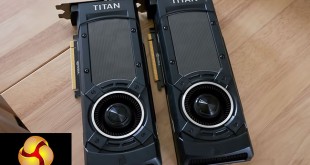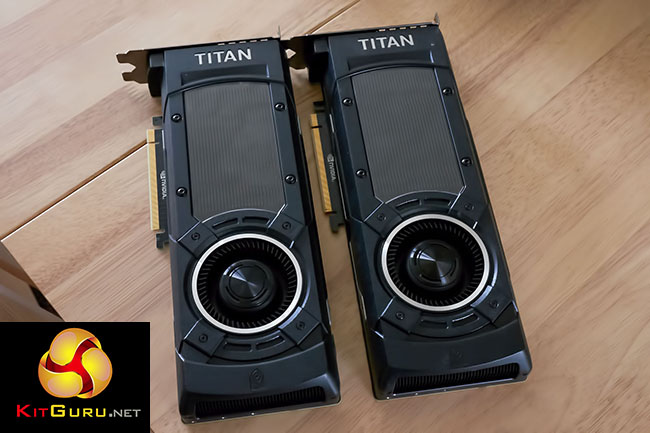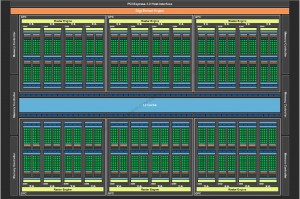
If you are considering a new Ultra HD 4K monitor then it is likely you will need a new system update to drive those 8,294,400 pixels. Right now the cost of 4k capable graphics cards is prohibitive for all but the wealthiest of gamers. When we reviewed the Titan X last month we noticed performance could still drop under 60 frames per second when dealing with the most demanding engines. We slot another card into our test bed – we answer the question ‘Are two Titan X's enough to drive 60fps+ at 4K?'

The Nvidia Titan X is based around the physically large GM200 die and is built on the 28nm process.

This is an extended 28nm die, 50 percent bigger than the one found on the GTX980. There are two more GPC clusters, enhancing the specifications to 3,072 cores and 192 texture units.
| GPU | GeForce GTX 750ti (Maxwell) | GeForce GTX 960 (Maxwell) | Geforce GTX 970 (Maxwell) | GeForce GTX 980 (Maxwell) | Geforce GTX Titan X |
| Streaming Multiprocessors | 5 | 8 | 13 | 16 | 24 |
| CUDA Cores | 640 | 1024 | 1664 | 2048 | 3072 |
| Base Clock | 1020 mhz | 1126 mhz | 1050 mhz | 1126 mhz | 1000 mhz |
| GPU Boost Clock | 1085 mhz | 1178 mhz | 1178 mhz | 1216 mhz | 1076mhz |
| Total Video memory | 2GB | 2GB | 4GB | 4GB | 12GB |
| Texture fill-rate | 40.8 Gigatexels/Sec | 72.1 Gigatexels/Sec | 109.2 Gigatexels/Sec | 144.1 Gigatexels/Sec | 192 Gigatexels/Sec |
| Memory Clock | 5400 mhz | 7010 mhz | 7000 mhz | 7000 mhz | 7000 mhz |
| Memory Bandwidth | 86.4 GB/sec | 112.16 GB/sec | 224 GB/s | 224 GB/sec | 336.5 GB/sec |
| Bus Width | 128bit | 128bit | 256bit | 256bit | 384bit |
| ROPs | 16 | 32 | 56 | 64 | 96 |
| Manufacturing Process | 28nm | 28nm | 28nm | 28nm | 28nm |
| TDP | 60 watts | 120 watts | 145 watts | 165 watts | 250 watts |
The Nvidia Titan X has 32 more ROPS than the GTX980, totaling 96. The memory interface has been set at a broad 384 bit … comprised of 6 x 64 bit pathways. This is more in line with the older generation of Nvidia hardware, like the GTX780 Ti – as the newer hardware has depended extensively on colour compression algorithms to improve overall efficiency.
Many readers are still under the impression that the Titan range of cards are not designed for gamers, but as I have explained multiple times, Nvidia have been marketing Titan hardware to the gaming enthusiast for years. Don’t take my word for it – the Titan Z for instance, according to Nvidia is a ‘gaming monster’. The Titan Black ‘gives you the added horsepower to drive your most graphics-intensive games’ – all on the Nvidia website here.
According to industry insiders, over 85% of all Titan sales are to the gaming enthusiast.
It is true that many professionals may have considered a Titan oriented graphics card, due to the double precision support. The standard Titan can handle DP calculations at 1/4 SP speed – which when compared directly to the 1/24 rate of the GTX780 Ti, is incredibly quick. The GTX 980 is rated at 1/32 SP and the Titan X is unfortunately no quicker. If you need a graphics card for double precision processing capabilities, then the Titan X is not for you – it is actually slower than the Kepler based Titan hardware from the previous generation.
Nvidia obviously want you to pay more for Double Precision performance, and they (not surprisingly) have a range of wallet sapping Quadro cards on offer, designed to deliver the goods. An example is the Quadro M6000 – built on the same GM200 die as the Titan X, but with much better DP performance. Just be prepared to pay out the ying-yang for the pleasure.
 KitGuru KitGuru.net – Tech News | Hardware News | Hardware Reviews | IOS | Mobile | Gaming | Graphics Cards
KitGuru KitGuru.net – Tech News | Hardware News | Hardware Reviews | IOS | Mobile | Gaming | Graphics Cards



The only conclusion I can reach after reading this article, is that AMD’s 295×2 is a badass deal
➧➧✥➧➧✥I RECEIVED FIRST DRAFT OF $13000!@ak36:
➨➨➨➨http://WebC0inCentral.com/gett/pr0fitables/2O15…
✔✔✔❣❣❣❣❣❣❣✔✔✔❣❣❣❣❣❣❣✔✔✔❣❣❣❣❣❣❣✔✔✔❣❣❣❣❣❣❣❣❣
man… The Titan X SLI makes no sense to me nvm the the Titan X alone “double precision processing capabilities” that was the whole marketing campaign for the Original titan.. Now the Titan is for gamers?? Still doesn’t perform well performance/price ratio. It’s ridiculous.. 2 Titan X sli only beating the 295×2 (year and a half old architecture” buy 10 frames?? $689 vs $2000? That’s pretty pathetic. Unfortunately for me I will be skipping this gen (the first time I will skip a gen 5800ultra)..This is why I don’t take reviews serious anymore from any website (I understand You get paid for this but you guys talk this up when you actually can see this makes no sense.
Not all compute workloads demand double precision. It is definitely marketed as a gaming card, but it is also marketed as a compute card. It truly is a single precision compute monster, and this is the main reason for the 12 GB of RAM, I think. The Quadro M6000 does not have more double precision performance than the Titan X. It is still FP64 at 1/32 FP32. It has ECC RAM, however.
Dude in 4k the titanx sli beats the 295×2 by at least 16 fps. Not looking at the 31 fps differnece in tomb raider 4k. Plus, ur looking at the 295×2 a year after it launched. Lets take a trip back to the day it was launched. It was 1500$ . so dont get modest about it now and say amd isnt a money sucking company. Both amd and Nvidia are. It is just how business runs nowadays. Yes the titanx doesnt justify the money. But when did the extreme enthusiasts products ever do? The intel 5960x doesnt justify the money. The 9590 from amd didnt justify the price/performance ratio when it launched for 800$. The 290x when launched was 700$. Water cooling doesnt justify the money compared to air cooling. I hope everyone sees this comment To change the obsolete logic that amd is a company that cares about people’s wallets and nvidia is a company that eat ur wallet. Noo, amd is just like nvidia.
Another Luxury vdeocard for the bloody rich
And still, there’s something that proves you wrong: R9 295X2 CrossFire
Yet, people are snatching the $1000.00 card up…
I hate it when peasants comment on things they can’t afford. lol.